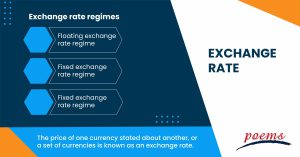Exchange rate
Table of Contents
Exchange rate
The foreign exchange market is a global, decentralized market where the world’s currencies trade. The main participants in the market are commercial banks, investment banks, central banks, hedge funds, and retail investors.
What is the exchange rate?
The price of one currency stated about another, or a set of currencies is known as an exchange rate. Changes in the currency rate impact the decisions made by people, corporations and the government. This impacts the balance of payments, inflation, and economic activity altogether.
An exchange rate is one at which one currency may be swapped for another between countries or economic zones. It is crucial in assessing the dynamics of commerce and capital movement since it is used to calculate the worth of different currencies compared to one another.
Understanding exchange rate
Currency is traded in pairs, with the first currency being the base currency and the second being the quote currency. The base currency is the currency being bought or sold, while the quote currency is the currency being used to price the base currency. For example, in the EUR/US$ currency pair, EUR is the base currency, and US$ is the quoted currency. This means that one euro is being traded for one US dollar.
Several factors, including economic and political conditions, interest rates, inflation, and the supply and demand of the currencies, determine exchange rates.
Two factors influence the exchange rates:
- The value of a domestic currency
- The value of a foreign currency
Furthermore, the rates may be given directly, indirectly, or by using cross-rates.
Exchange rate classifications
There are two main types of exchange rate classifications: floating and fixed.
- Floating
A floating exchange rate is one where the value of a currency is allowed to fluctuate in response to market forces, such as supply and demand.
- Fixed
A fixed exchange rate is one where the value of a currency is pegged to another currency or a basket of currencies.
Measuring the exchange rate
- Bilateral exchange rate
An exchange rate can be calculated in various ways. The most common approach is to evaluate a bilateral exchange rate. The valuation of one currency against another is referred to as a bilateral exchange rate. Since the US$ is the most traded currency worldwide, bilateral exchange rates are often stated against it.
Our everyday lives are affected by bilateral exchange rates, frequently covered in the media. When customers buy products and services from other nations or go abroad, they are exposed to them. When companies sign agreements to sell their services and products to other countries and buy manufacturing inputs from other nations, they are exposed to them.
- Trade-weighted index (TWI)
Although bilateral exchange rates remain the ones most usually used (and are more likely to appear in the media), a trade-weighted index (TWI) offers a more comprehensive indicator of overall movements in a currency. This is so because a TWI measures the value of a local currency as a weighted average of a collection of currencies, or “basket” (rather than a single foreign currency).
The percentage of trade performed among each country’s trading partners is often used to determine the weights of each currency in the basket (usually total trade shares, but import or export shares can also be used). A TWI may therefore determine whether a currency is, on average, appreciating or depreciating about its trade partners.
- Cross rates
The “cross rates” calculation is also based on bilateral exchange rates. An exchange rate determined using a third currency is a cross rate.
For instance, if both the exchange rates for the SGX and the euro (EUR) against the US$ are known, the exchange rate between the two currencies may be determined using the SGX/US$ and EUR/US$ rates (i.e., EUR/SGX = EUR/US$ x US$/SGX).
Exchange rate regimes

There are three main exchange rate regimes: floating, fixed and pegged.
- Floating exchange rate regime
In a floating exchange rate regime, the currency is allowed to fluctuate based on market forces.
- Fixed exchange rate regime
In a fixed exchange rate regime, the currency is pegged to another currency, usually the US dollar.
- Pegged exchange rate regime
The currency is pegged to a basket of currencies in a pegged exchange rate regime.
Frequently Asked Questions
Several factors can affect the exchange rate between two currencies. Some of the most important factors include the economic conditions of the countries involved, the relative demand for the currencies, the level of inflation in the countries, and the level of interest rates. Other factors influencing the exchange rate include political stability, the availability of foreign exchange reserves, and the level of trade between the countries.
The inevitable result of fluctuating exchange rates, which are the norm for most large economies, is currency volatility. Exchange rates are influenced by various factors, such as a nation’s economic performance, the likelihood of inflation, interest rate differences, capital movements, and more.
The collapse of the Japanese yen carry trade, and the Asian financial crisis are two examples of significant currency movements that influenced the financial markets.
When a country’s currency weakens, its exports become cheaper for other countries to buy. This can lead to a increase in demand for the country’s goods.
A country’s currency can also affect imports, as a weaker currency will make imported goods more expensive.
Exchange rates are important because they provide a way for countries to trade with each other. They also help determine the price of goods and services in different countries. Exchange rates can be affected by several factors, including economic conditions, political stability, and demand for a particular currency.
Use this equation to determine the exchange rate if you don’t know it:
initial amount (base currency)
—————————————————
final amount (foreign currency)
Calculate the exchange rate for your currencies if you were trading on the forex market by using the previously given currency conversion formulas.
Related Terms
- Trailing Stops
- Exchange Control
- Relevant Cost
- Dow Theory
- Hyperdeflation
- Hope Credit
- Futures contracts
- Human capital
- Subrogation
- Qualifying Annuity
- Strategic Alliance
- Probate Court
- Procurement
- Holding company
- Harmonic mean
- Trailing Stops
- Exchange Control
- Relevant Cost
- Dow Theory
- Hyperdeflation
- Hope Credit
- Futures contracts
- Human capital
- Subrogation
- Qualifying Annuity
- Strategic Alliance
- Probate Court
- Procurement
- Holding company
- Harmonic mean
- Income protection insurance
- Recession
- Savings Ratios
- Pump and dump
- Total Debt Servicing Ratio
- Debt to Asset Ratio
- Liquid Assets to Net Worth Ratio
- Liquidity Ratio
- Personal financial ratios
- T-bills
- Payroll deduction plan
- Operating expenses
- Demand elasticity
- Deferred compensation
- Conflict theory
- Acid-test ratio
- Withholding Tax
- Benchmark index
- Double Taxation Relief
- Debtor Risk
- Securitization
- Yield on Distribution
- Currency Swap
- Overcollateralization
- Efficient Frontier
- Listing Rules
- Green Shoe Options
- Accrued Interest
- Market Order
- Accrued Expenses
- Target Leverage Ratio
- Acceptance Credit
- Balloon Interest
- Abridged Prospectus
- Data Tagging
- Perpetuity
- Hybrid annuity
- Investor fallout
- Intermediated market
- Information-less trades
- Back Months
- Adjusted Futures Price
- Expected maturity date
- Excess spread
- Quantitative tightening
- Accreted Value
- Equity Clawback
- Soft Dollar Broker
- Stagnation
- Replenishment
- Decoupling
- Holding period
- Regression analysis
- Wealth manager
- Financial plan
- Adequacy of coverage
- Actual market
- Credit risk
- Insurance
- Financial independence
- Annual report
- Financial management
- Ageing schedule
- Global indices
- Folio number
- Accrual basis
- Liquidity risk
- Quick Ratio
- Unearned Income
- Sustainability
- Value at Risk
- Vertical Financial Analysis
- Residual maturity
- Operating Margin
- Trust deed
- Leverage
- Profit and Loss Statement
- Junior Market
- Affinity fraud
- Base currency
- Working capital
- Individual Savings Account
- Redemption yield
- Net profit margin
- Fringe benefits
- Fiscal policy
- Escrow
- Externality
- Multi-level marketing
- Joint tenancy
- Liquidity coverage ratio
- Hurdle rate
- Kiddie tax
- Giffen Goods
- Keynesian economics
- EBITA
- Risk Tolerance
- Disbursement
- Bayes’ Theorem
- Amalgamation
- Adverse selection
- Contribution Margin
- Accounting Equation
- Value chain
- Gross Income
- Net present value
- Liability
- Leverage ratio
- Inventory turnover
- Gross margin
- Collateral
- Being Bearish
- Being Bullish
- Commodity
- Basis point
- Inception date
- Riskometer
- Trigger Option
- Zeta model
- Racketeering
- Market Indexes
- Short Selling
- Quartile rank
- Defeasance
- Cut-off-time
- Business-to-Consumer
- Bankruptcy
- Acquisition
- Turnover Ratio
- Indexation
- Fiduciary responsibility
- Benchmark
- Pegging
- Illiquidity
- Backwardation
- Backup Withholding
- Buyout
- Beneficial owner
- Contingent deferred sales charge
- Exchange privilege
- Asset allocation
- Maturity distribution
- Letter of Intent
- Emerging Markets
- Consensus Estimate
- Cash Settlement
- Cash Flow
- Capital Lease Obligations
- Book-to-Bill-Ratio
- Capital Gains or Losses
- Balance Sheet
- Capital Lease
Most Popular Terms
Other Terms
- Physical ETF
- Initial Public Offering
- Buyback
- Secondary Sharing
- Bookrunner
- Notional amount
- Negative convexity
- Jumbo pools
- Inverse floater
- Forward Swap
- Underwriting risk
- Reinvestment risk
- Final Maturity Date
- Payment Date
- Secondary Market
- Margin Requirement
- Mark-to-market
- Pledged Asset
- Yield Pickup
- Subordinated Debt
- Treasury Stock Method
- Stochastic Oscillator
- Bullet Bonds
- Basket Trade
- Contrarian Strategy
- Notional Value
- Speculation
- Stub
- Trading Volume
- Going Long
- Pink sheet stocks
- Rand cost averaging
- Sustainable investment
- Stop-limit sell order
- Economic Bubble
- Ask Price
- Constant prepayment rate
- Covenants
- Stock symbol
- Companion tranche
- Synthetic replication
- Bourse
- Beneficiary
- Witching Hour
- Widow and Orphan stock
- Public Float
- Closing Price
- Reverse stock splits
- Quiet period
- Prepayment risk
Know More about
Tools/Educational Resources
Markets Offered by POEMS
Read the Latest Market Journal

Back in Business: The Return of IPOs & Top Traded Counters in March 2024
Start trading on POEMS! Open a free account here! At a glance: Major indices continue...

Weekly Updates 15/4/24 – 19/4/24
This weekly update is designed to help you stay informed and relate economic and company...

From $50 to $100: Unveiling the Impact of Inflation
In recent years, inflation has become a hot topic, evoking strong emotions as the cost...

Japan’s Economic Resurgence: Unveiling the Tailwinds Behind Nikkei 225’s Record Leap
Source: eSignal, Intercontinental Exchange, Inc. In the heart of Japan’s economic landscape, the Nikkei 225...

Weekly Updates 8/4/24 – 12/4/24
This weekly update is designed to help you stay informed and relate economic and...

What Makes Forex Trading Attractive?
In a world where the click of a button can send goods across oceans and...

Weekly Updates 1/4/24 – 5/4/24
This weekly update is designed to help you stay informed and relate economic and company...

How to soar higher with Positive Carry!
As US Fed interest rates are predicted to rise 6 times this year, it’s best...












